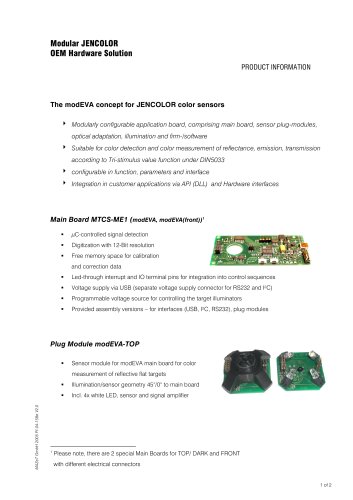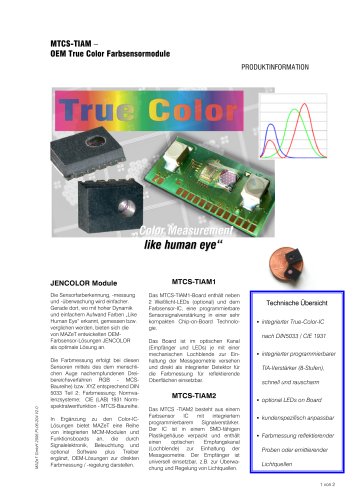
Catalog excerpts

Daniel Wiese, Karlheinz Blankenbach Pforzheim University, Engineering Department Electronics and Information Technology Tiefenbronner Str. 65, D-75175 Pforzheim, Germany Contact: Fon: +49 7231 28 6658 ; Fax: - 6060 ; Email: kb@displaylabor.de Abstract Colour measurements are usually performed by measurement devices in the range of 1,000 to 100,000 ր. We have evaluated the low cost approach with the MAZET MCTS 2 colour system regarding absolute accuracy and usability for display applications. The USB-powered sensor is available with standard software which is capable to measure absolute colour co-ordinates with an universal calibration. Additionally, this software allows calibrating the sensor to a special target (display, light source) with reference images or high end colour measurement devices. Because the original software is more dedicated to perform various measurement tasks rather than display relevant applications, two programs were developed by us. One is for automatic calibration with a YOKOGAWA colorimeter, the other one captures the most relevant optical PC-monitor parameters (max. luminance, dark room contrast ratio, gamma values, colour co-ordinates and gamut) by just one click. The accuracy of the MAZET MTCS 2 was evaluated in two ways: First, measurements and calibration with the original software and second by using of well known calibration algorithms in our own software. All programs show nearly the same results for measurements of PC-monitors: the absolute accuracy (with common calibration) we achieved is about ∆ E* ≈ 10 - 15 and, if the sensor is calibrated to the display, ∆ E* ≈ 1 - 3 ( ∆ E* is the colour difference acc. CIE 1976 LUV). Therefore the MAZET MCTS 2 shows an excellent performance when calibrated to the display under test. For absolute measurements its accuracy is however limited. 1 Introduction Colour measurements are necessary in many applications like evaluating of specifications as well as calibration of displays and control of colour light sources (e.g. LED backlights of LCDs). In multimedia systems usually device-dependant colour co-ordinates like RGB are used (e.g. stored in a file) and this leads often to colour shifts when displaying this on another device-dependant system like a monitor. So a better way is paved by device-in dependent colour systems like CIE. As a consequence of this, RGB-based devices have to be measured for grey scale, colours and gamut with standard colours (e.g. GRETAGMACBETH COLOURCHECKER) in order to generate corrections files (ICM). In display metrology it is always a task to find the right balance between accuracy and costs. There are several colour measuring instruments available, but high accuracy means also high price. On the other side, many applications require a colour measurement capability that is cost-effective and has a sufficient accuracy. The latter can only be achieved with low cost sensors that are calibrated to the specific display (target). In this article we focus on the cost-saving task by evaluating the accuracy of MAZETs [1] low-cost colour sensor MTCSICS on a new (2006) evaluation board (MTCS 2). >
Open the catalog to page 1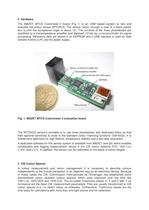
2 Hardware The MAZET MTCS Colorimeter 2 board (Fig. 1) is an USB based system to test and evaluate the colour sensor MTCSICS. The sensor looksђ through a hole of a black plastic box to limit the acceptance angle to about 10. The currents of the three photodiodes are amplified by a transimpedance amplifier and digitized (10-bit) by a microcontroller for signal processing. Reference data are stored in an EEPROM and a USB interface is used for data transfer from/to a PC and for power supply. Fig. 1: MAZET MTCS Colorimeter 2 evaluation board The MTCSICS sensorВs principle is to use three...
Open the catalog to page 2
To obtain Tristimulus values from a spectrum (intensity of light related to wavelengths) it has to be multiplied with the Colour Matching Functions (CMF, see Fig. 2) for each wavelength and all those products are summarized over the visible wavelengths. Fig. 2: Colour matching functions (CMF) [3] This approach is used by monochromators and spectroradiometers. The other way to use at least 3 photodiodes with dedicated filters so that a spectral sensitivity of the colour matching functions is achieved. This is however difficult as the spectral response of photodiodes is completely different...
Open the catalog to page 3
Difference of a human observer via E* = 1. A value for > * E > * = 5 is the difference that can be easily differentiated by human eye, E > 20 is specified in ISO 15008 for minimum colour discrimination. The colour difference E > * in the CIELUV (1976, non-linear transformation of XYZ) is defined as shown in Formula 2 (see e.g. [5]). > Colour22anceminLu2**uv Formula 2: Calculation of the colour difference E > * in the CIELUV system Fig. 3: CIE 1931 Lxy (left, [4]) and CIE 1976 UCS (right, [5]) 4 Evaluation of the Sensor Board with MAZET Software First tests of the low cost sensor were done...
Open the catalog to page 4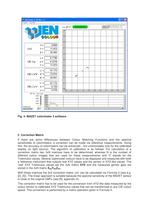
Fig. 4: MAZET colorimeter 2 software If there are some differences between Colour Matching Functions and the spectral sensitivities of colorimeters, a correction can be made via reference measurements. Doing this, the accuracy of colorimeters can be enhanced but unfortunately only for the calibrated display (or light source). The algorithm of calibration is as follows: For calculation of a correction matrix two 3xN matrices have to be determined, whereas N is the number of different colour images that are used for these measurements and ֑3 stands for the Tristimulus values. Several...
Open the catalog to page 5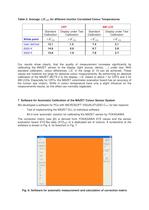
Table 2: Average E > *LUV for different monitor Correlated Colour Temperatures CRT AM LCD Standard Calibration Display under Test Calibration Standard Calibration Display under Test Calibration White point E > *avg E > *avg E > *avg E > *avg User defined 13.1 1.4. 7.4 3.1 6500 K 14.6 0.9 6.7 2.8 9300 K 13.8 1.0 7.8 2.7 Our results show clearly, that the quality of measurement increases significantly by calibrating the MAZET sensor to the display (light source, device, ) under test. With standard calibration, colour differences E > * in the range of 10 can be achieved. These values are...
Open the catalog to page 8All Ams Sensors Germany GmbH catalogs and technical brochures
-
Company Brochure
20 Pages
-
EMS Services incl. Design
2 Pages
-
MTCS-C3
2 Pages
-
ASIC Design Service Guide
4 Pages
-
JENCOLOR
2 Pages
-
Redesign of obsolete ASICs
2 Pages
-
MAZeT Flyer
2 Pages
-
JENCOLOR Flyer
2 Pages
-
JENCOLOR- True Color Sensors
2 Pages
-
MAZeT GmbH company facts
20 Pages
Archived catalogs
-
MRGBiCT
7 Pages
-
MRGBiCS
9 Pages
-
Data Sheet - MCS3AT/BT
7 Pages
-
Data sheet - MCS3AS
7 Pages
-
Product information - MCS3
2 Pages
-
Data Sheet - MTI04
12 Pages
-
Software Description MTCS-ME1
20 Pages
-
Data Sheet - MTCS-ME1
25 Pages
-
Data Sheet - MTCSiCS
8 Pages
-
MAZeT flyer
2 Pages























